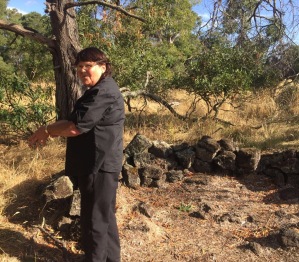Visiting Gunditjmara Country
I recently returned from one of the most mind-opening trips on which I have ever been: a visit to Gunditjmara country in western Victoria (pink territory, bottom left on map).
Along with nine other members of the University’s executive, I got to spend two days meeting with both elders and young people, being shown around their traditional lands and hearing their stories. The visit was undertaken as one small, but significant, component of the University’s intensifying commitment to the national need to advance the cause of reconciliation.
Reconciling the hopes and narratives of the first inhabitants of a land with those of the people who came later is a major challenge almost everywhere the issue exists. In Australia we still struggle mightily with it. This university has recently taken major steps to intensify its efforts to accelerate the process of reconciliation. And the inspirational Stacey Campton who heads RMIT’s Ngarara Willim Centre is a powerful catalyst for action and optimism.
Our visit was deeply moving. All of us were emotionally affected by accounts of the tragedies and suffering that followed the arrival of European settlers. Perhaps the most graphic episode of this was the massacre of Aboriginal people in 1834 following a clash over rights to a whale harpooned by settlers and brought ashore to a beach just outside Portland.
Also striking were accounts of the harsh realities of life for Aboriginal people forced to live on missions, such as the Lake Condah Mission (opened in 1867). And yet harsher still were the realities of life for those excluded from the missions and other sanctioned settlements. Having sorrowfully outlined the hardships and enduring consequences of mission life, Gunditjmara elder Auntie Maude went on to say “But if it wasn’t for the mission, we might not have survived at all.”
Our discussions were not all about past tragedies and their enduring consequences. We also learned about  the remarkable remnant stone dwellings and sophisticated seasonal stone fish traps in Gunditjmara country – a surprise given the conventional wisdom about the nomadic existence of Aboriginal people in Australia (see story and recontruction).
the remarkable remnant stone dwellings and sophisticated seasonal stone fish traps in Gunditjmara country – a surprise given the conventional wisdom about the nomadic existence of Aboriginal people in Australia (see story and recontruction).
I was especially interested to learn how the local Aboriginal community centre, Winda Mara, is structured as a company and operates to provide local health and welfare services and help launch Aboriginal into labour market. This challenged some of my preconceptions. Meeting the young men and women working at and with Winda Mara, and hearing their stories and outlooks on life was a source of hope and optimism for a better future.
Running through everything in our visit to Gunditjmara country were the intertwined issues of race, identity and the possibilities of reconciliation. For me, perhaps the most powerful comment of our visit was the stark declaration of visiting elder, Uncle Mick (himself a survivor of being stolen or kidnapped from his parents at an early age): “There is only one race on this planet, and that is the red-blooded human race.”
I left Gunditjmara country with whole different outlook. Certainly I have a much sharper appreciation of the suffering Aboriginal people have endured, but I also have a clearer sense of hope and possibility.
Let me give the last word to my wonderful colleague, Stacey Campton. In a short clip, she spoke with me in a moving way on the shore of beautiful Lake Bridgewater, and we ended on a theme to which I will return: how we hold together the imperative of embracing Uncle Mick’s injunction about there being only one human race, with our desire for also belonging to particular cultures and communities.